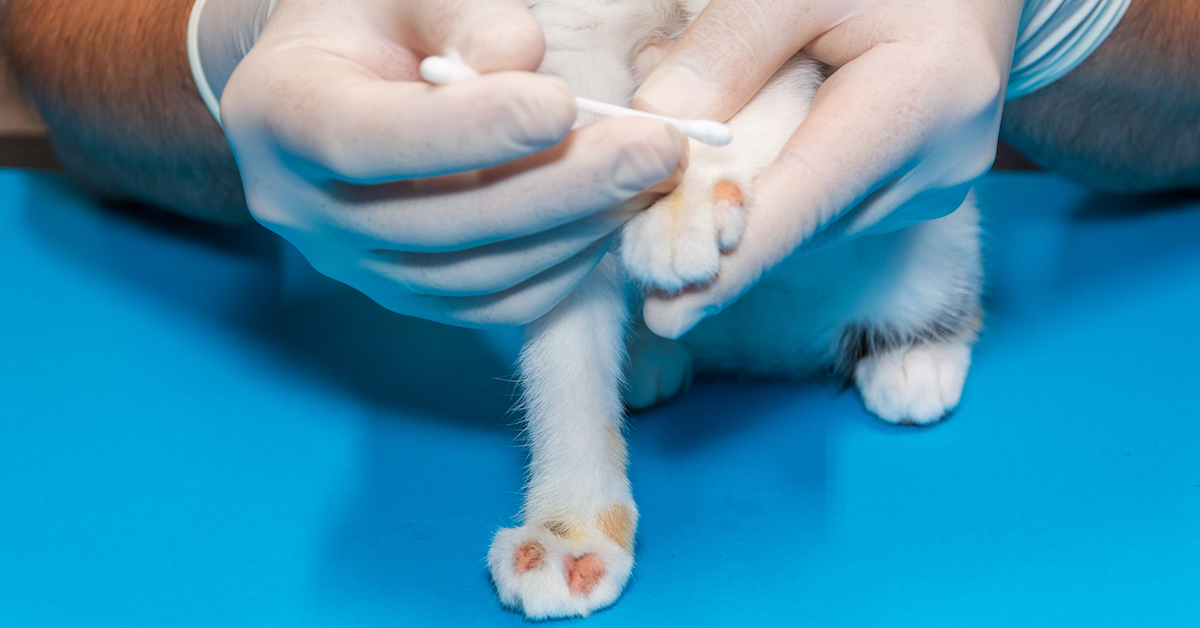Ringworm in Cats: What Is It and How Is It Treated?
Ringworm is one of the most common skin problems that develop in kittens and cats.

Ringworm is a common skin infection that is often misunderstood due to its revolting name. Also known as dermatophytosis, ringworm is the most common type of fungal infection that cats can develop in just a few hours after coming into contact with spores. Despite its name, ringworm is not actually caused by a worm but rather a fungus. Ringworm is very contagious and can spread easily in both humans and animals. Although this condition will often go away on its own, it can take a long time without treatment. Learn more about ringworm in cats and how it is typically treated.
What Is Ringworm?
Ringworm is the most common type of fungal infection in cats. Different types of fungus can cause the infection but approximately 98 percent of cat ringworm infections are the result of a fungus known as Microsporum canis. The fungus generally has a two-week incubation period between exposure and symptoms but sometimes cats will exhibit symptoms much sooner. In addition, the fungus remains transmissible even before symptoms develop.
Cats can develop ringworm when they come into contact with the fungus. The fungus responsible for ringworm can live on a variety of surfaces, such as towels, blankets, and grooming tools. This fungus can also survive on the hair or skin of infected humans and animals. This means that your cat could get ringworm from being brushed using the same equipment used to groom an infected pet or by sleeping next to an infected pet on the same bedding.
What are the Symptoms of Ringworm?
There are several signs that could indicate that your cat has a ringworm infection. As the name implies, a ringworm infection generally appears as a rash in the shape of a ring. This rash may appear on the cat’s face, ear tips, tail, or feet. Some infections may be accompanied by small to large solid bumps with open sores. While most rashes are ring-shaped, some cats may develop rashes in irregular shapes.
Some of the most common symptoms of ringworm in cats include:
- Redness
- Crusting
- Dandruff
- Stubbly hair
- Excessive grooming
- Claw infections
- Flaking
- Scaling
- Hair loss
How Is Ringworm in Cats Diagnosed?
If you suspect that your cat may have ringworm, it is important to bring her to the vet for a proper diagnosis. It is also a good idea to keep your pet isolated until her appointment to prevent her from spreading the infection to others. When you bring your cat to the vet, pick her up with gloves or wrap her in a towel before placing her into her pet carrier.
There are several tests that your vet may perform to test for ringworm. Skin cultures are often used, as well as PCR tests. Polymerase chain reaction (PCR) tests are a fast and highly accurate way to diagnose certain infectious diseases. A vet may use a PCR test to help identify the specific type of fungus causing the ringworm infection.
The use of a Wood’s lamp can also be effective in determining what hairs and areas of skin have been affected by ringworm. This handheld tool uses ultraviolet light to closely examine the cat’s skin and fur. Any affected areas of skin or hair will glow under the light. Your vet can then take a swab of these areas for testing.
How Is Ringworm Treated in Cats?
While no pet owner wants to hear a diagnosis of ringworm, they can feel good knowing that the infection is completely treatable. Work directly with your vet to develop a custom treatment plan for your cat. A typical treatment plan for ringworm in cats consists of a combination of topical and oral anti-fungal topical treatments.
Oral therapies may include prescribed medications like itraconazole, griseofulvin, and terbinafine. Topical treatments may include ointments, creams, or shampoos that are applied directly to the affected areas of the skin. Regardless of what type of treatment is recommended, it’s important to follow all instructions provided by your vet.
How effective treatment is at getting rid of ringworm will depend on a variety of factors. Only a culture for dermatophytes, a ringworm-causing agent, can effectively monitor a cat’s response to treatment. If a ringworm infection is particularly resistant, it could take weeks or even months to get rid of an infection.
It is important to remember that while ringworm infections will often go away on their own, it could take many months for a case of ringworm to resolve itself. In the meantime, your pet could suffer from skin irritation and even infections if they proceed to scratch or lick at the skin. During this time, the infection could also spread to others.
During treatment, prevent the spread of ringworm to other pets and humans in the household by taking extra precautions. Always wear gloves while handling a pet that has ringworm and wash your hands with soap and water whenever you touch a cat with this condition.
You’ll also want to vacuum your home regularly to remove skin flakes and fur that could spread ringworm. Remove any cat hair from bedding, furniture, and clothing, and thoroughly disinfect surfaces where your cat likes to hang out, such as tables, countertops, or their pet carrier.
While ringworm can be a nuisance for pet owners, it is fortunately treatable without any lasting side effects in the majority of cases. Treatment generally works fast to get rid of the infection and you can keep your other pets and family safe during treatment through proper isolation measures. Early treatment can keep your cat in its best health.
Ready to start saving money on pet wellness care?
Then take a look at Mint Wellness, the pet wellness plan that provides fast reimbursement on routine pet care. Save on vaccinations, wellness exams, preventatives, dental, and more!
Learn More


